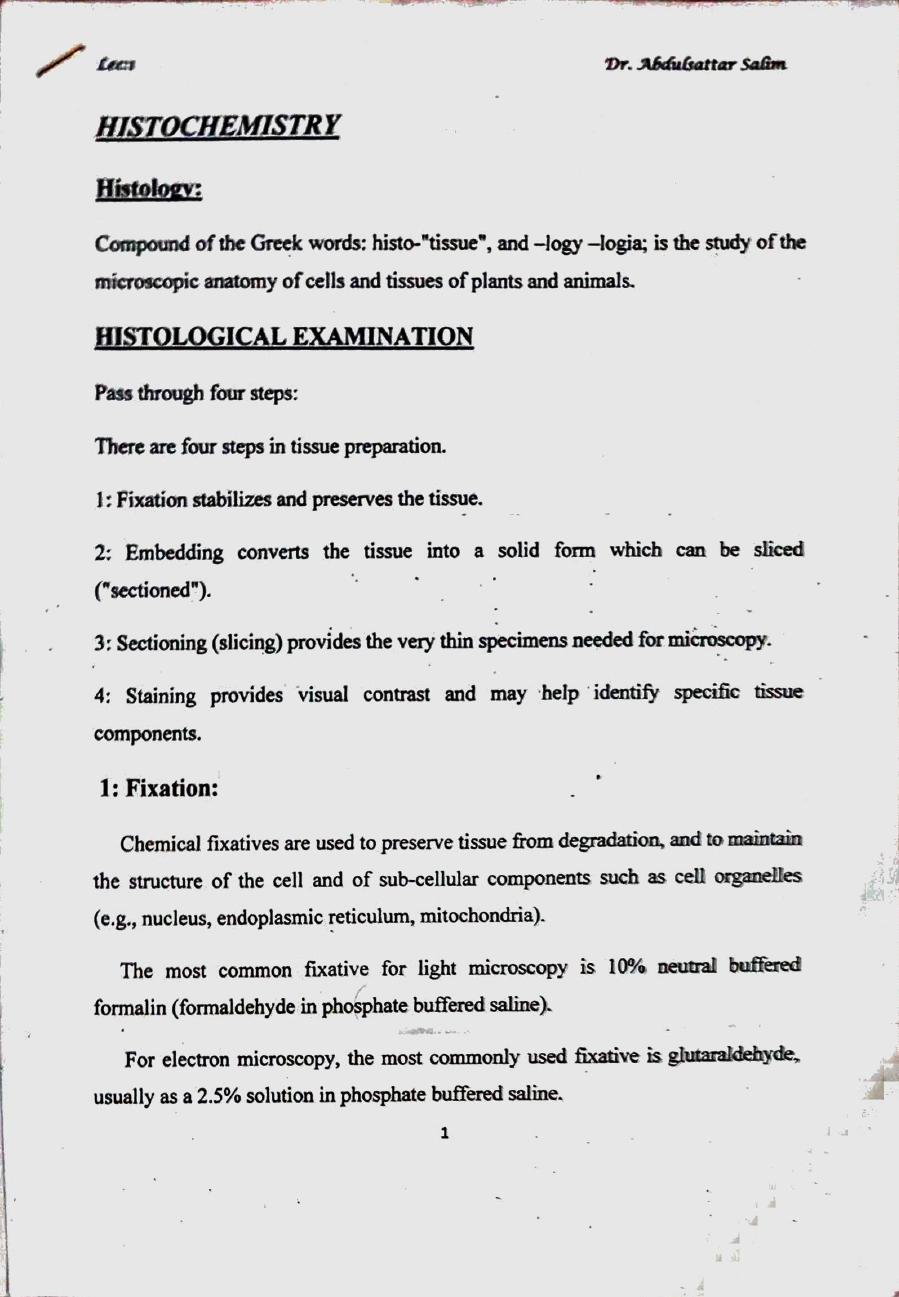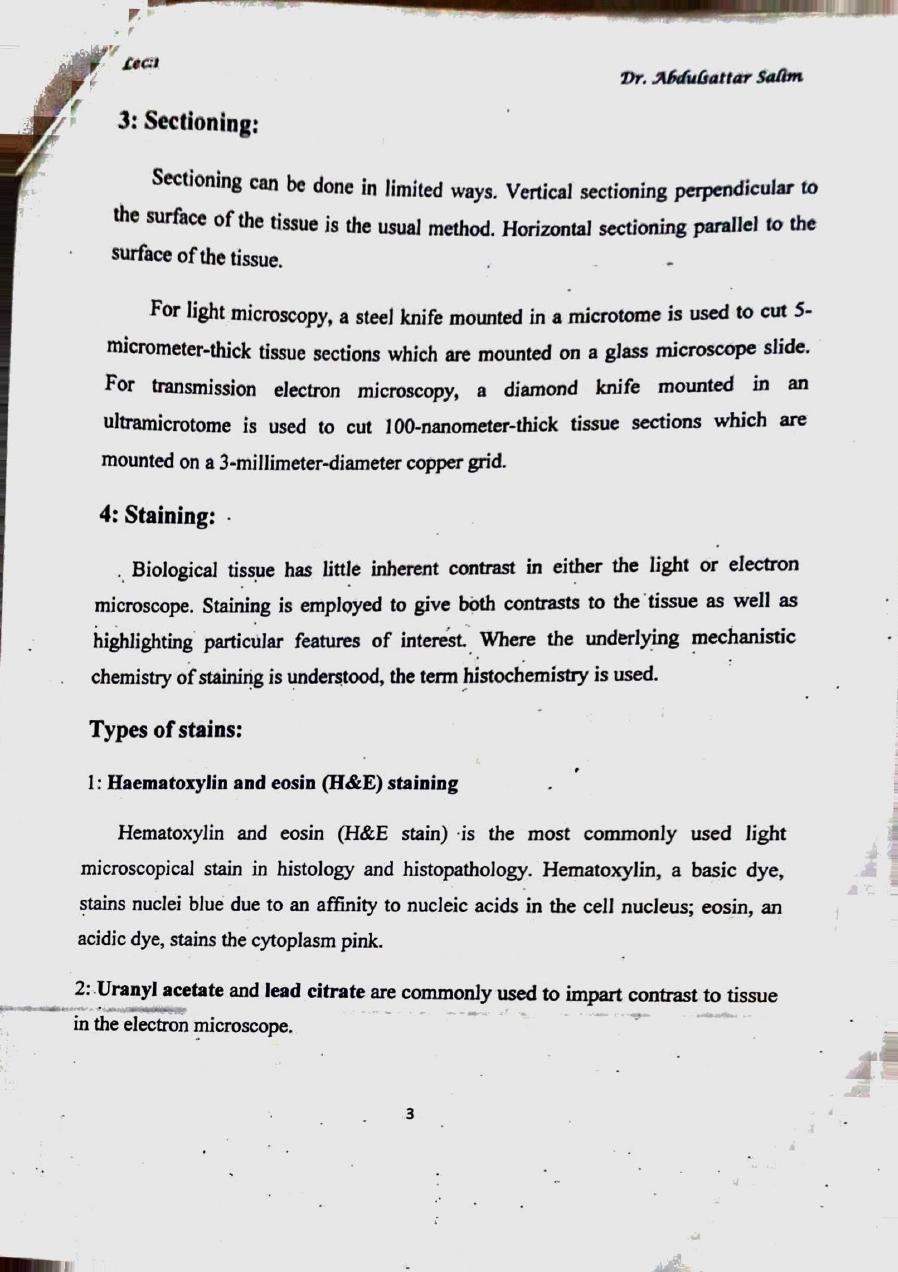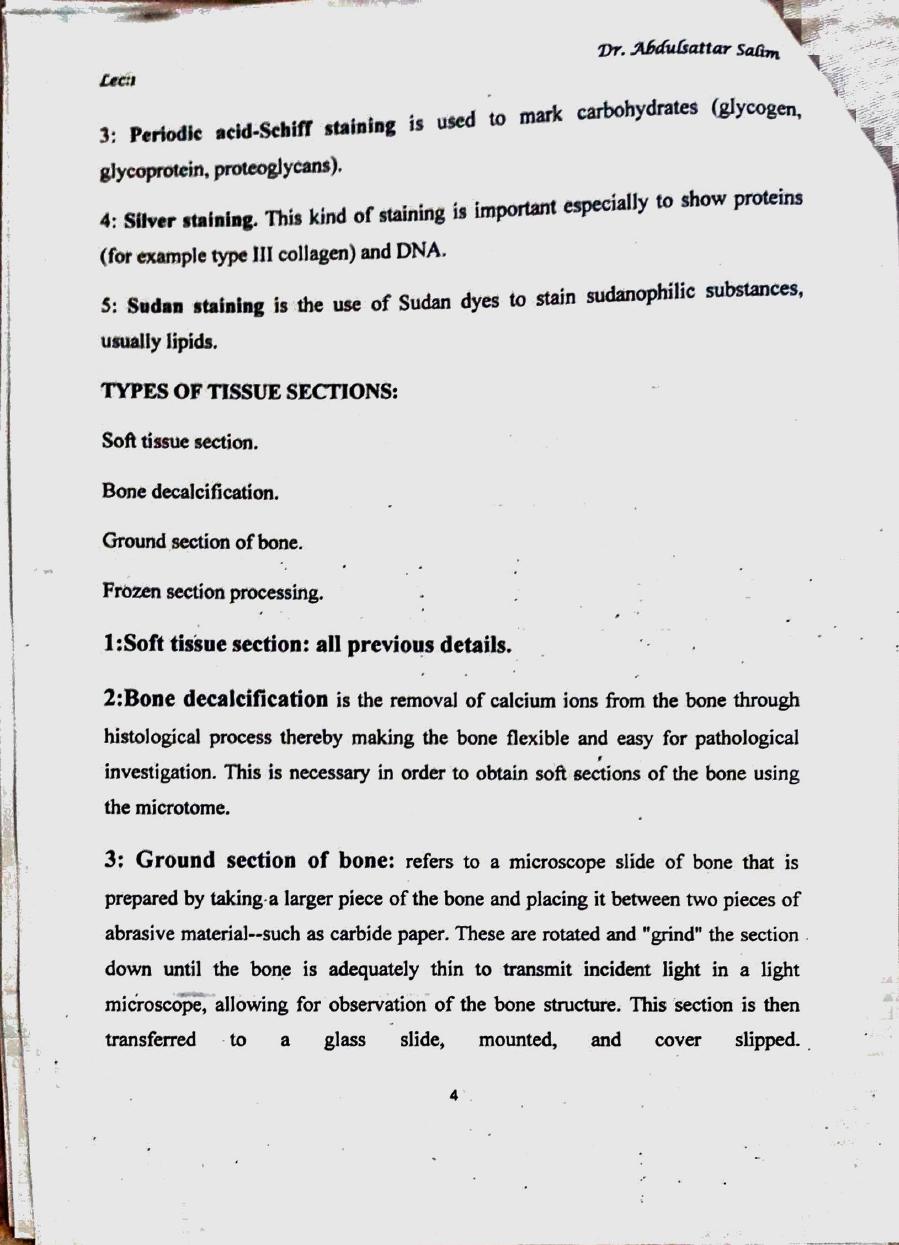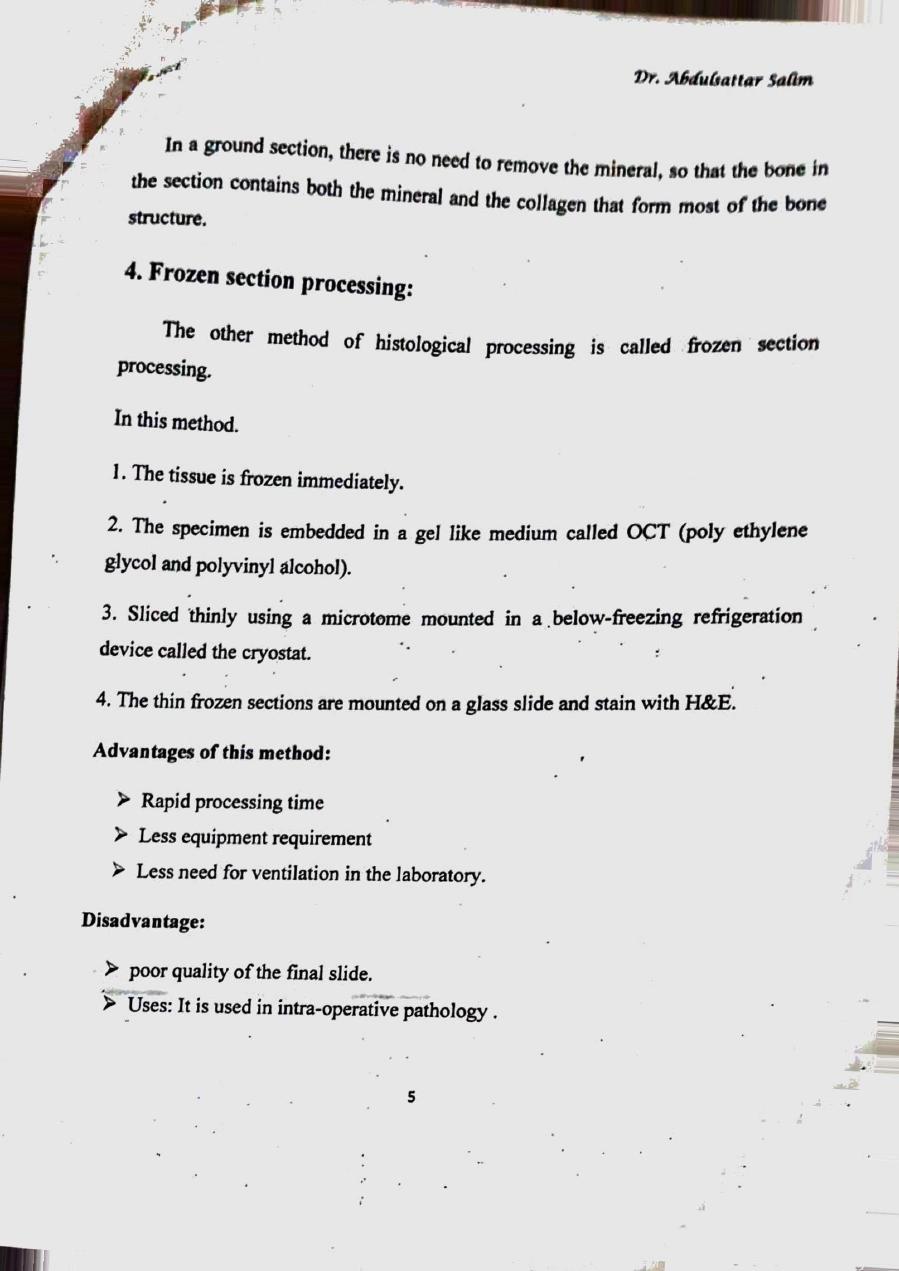
Dr. -AÆGattar
HISTOCHEMISTRY
Cmtpound of the Greek words: histo-«tissuee, and —log —logia;
is the study of the
micrøcqic anatomy of cells and tissues of plmts and animals.
HISTOLOGICAL EXAMINATION
Pass through four steps:
There are four steps in tissue preparation.
J : Fixation stabilizes and preserves the tissue.
2: Embedding converts the tissue into a solid form which cm be sliced
("sectioned").
3'. Sectioning (slicing) provides the very thin specimens needed for microscopy.
4: Staining provides visual contrast and may help identiö' specific tissue
components.
1: Fixation:
Chemical fixatives are used to preserve tissue from degadation, and to maintain
the structure of the cell and of sub-cellular components such
cell
(e.g., nucleus, endoplasmic reticulum, mitochondria).
The most common fixative for light microscopy is IV. neutral buffaed
formalin (formaldehyde in phosphate buffered saline).
For electron microscopy, the most commonly used fixative
glutarald&yde,
usually as a 2.5% solution in phosphate buffered saline.
1

Dr. AbduGattar
sqtih
teei
2: Embedding ( dehydration, clearing. and
infiltration):
aim of tissue embedding
i: To remove water from tissues 2: Replace with a medium that solidifies to allow
thin sections to be cut.
3: Biological tissue must be presented and supported in a hard matrix to allow
sufficiently thin sections to be cut without any destortion.
Steps of Embedding:
Firstly the tissue needs to be dehydrated to remove the water from the tissue
which is present- either bound to the tissue, or free in the tissue. Paraffin wax is
hydrophobic, therefore, most of the water in the tissue must be removed before it
Can be infiltrated with wax. This process is carried out by immersing tissue in a
series of ethanol solutions of increasing concermtions until 100%, water-free
alcohol is reached. A series of increasing concentrations is used 10 ensure that the
water in the tissue is gadually replaced by the alcohol and to avoid excessive
distortion of the tissue.
Clearing: Although the tissue reaches the final stage of dehydration in 100%
ethanol, it's not possible to proceed straight to wax embedding- ethanol and wax
don't mix!
Following the dehydration, the tissue is immersed in one to three different
xylene immersions. In these stages, the ethanol is gadually replaced with xylene
and when the tissue is embedded, the xylene will be replaced by the molten
paraffn wax in which the wax infiltrated to the all structures of cell and harden
therh.
2

Dr. Abdu6attar Sanm
3: Sectioning:
Sectioning can be done in limited ways. Vertical sectioning perpendicular to
the surface of the tissue is the usual method. Horizontal sectioning parallel to the
surface of the tissue.
For light microscopy, a steel knife mounted in a microtome is used to cut 5-
micrometer-thick tissue sections which are mounted on a glass microscope slide.
For transmission electron microscopy, a diamond Jaffe mounted in an
ultramicrotome is used to cut 100-nanometer-thick tissue sections which are
mounted on a 3-millimeter-diameter copper grid.
4: Staining:
Biological tissye has little inherent contrast in either the light or electron
microscope. Staining is employed to give both contrasts to the tissue as well as
highlighting particular features of interest. Where the underlying mechanistic
chemistry of staining is understood, the tem histochemisüy is used.
Types of stains:
l: Haematoxylin and eosin (H&E) staining
Hematoxylin and eosin (H&E stain) •is the most commonly used light
microscopical stain in histology and histopathology. Hematoxylin, a basic dye,
stains nuclei blue due to an affinity to nucleic acids in the cell nucleus; eosin, an
acidic dye, stains the cytoplasm pink.
2: Uranyl acetate and lead citrate are commonly used to impart contrast to tissue
in the electron microscope.
3

Dr. AbduGattar Saam
3: Periodic acid-Schiff
staining is used to
mark carbohydrates
(glycogem
glycoprotein, proteoglyeans).
4: Silver staining. fiis kind of staining is
important especially to show
proteins
(for example type Ill collagen) and DNA.
S: Sudan staining is the use of Sudan dyes to stain
sudanophilic substances,
usually lipids.
TYPES OF TISSUE SECITONS•.
Soft tissue section.
Bone decalcification.
Ground section of bone.
Frozen section processing.
1:Soft tissue section: all previous details.
2:Bone decalcification is the removal of calcium ions from the bone through
histological process thereby making the bone flexible and easy for pathological
investigation. This is necessary in order to obtain soft sections of the bone using
the microtome.
3: Ground section Of bone: refers to a microscope slide of bone that is
prepared by taking•a larger piece of the bone and placing it between two pieces of
abrasive material--such as carbide paper. These are rotated and "grind" the section
down until the bone is adequately thin to transmit incident light in a light
microscope, allowing for observation of the bone structure. This section is then
transferred
to
a
glass
slide,
mounted,
and
cover
slipped.
4

Dr. .AMu6attar Sanm
In a ground section, there is no
need to remove the mineral, so that the bone in
the section contains both the
mineral and the collagen that form most or the bone
structure.
4. Frozen section processing:
ne other method of histological processing is called frozen section
processing
In this method.
1. The tissue is frozen immediately.
2. The specimen is embedded in a gel like medium called OCT (poly ethylene
glycol and polyvinyl alcohol).
3. Sliced thinly using a microtome mounted in a below-freezing refrigeration
device called the cwostat.
4. The thin frozen sections are mounted on a glass slide and stain with H&E.
Advantages of this method:
Rapid processing time
Less equipment requirement
Less need for ventilation in the laboratory.
Disadvantage:
poor quality of the final slide.
Uses: It is used in intra-operative pathology .
5
